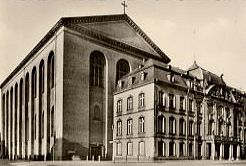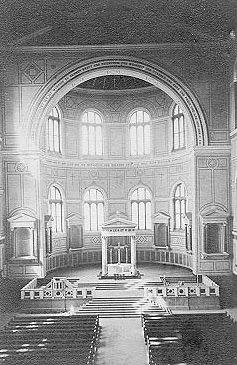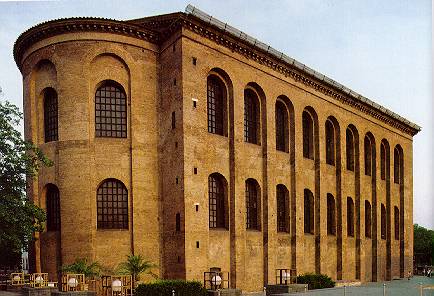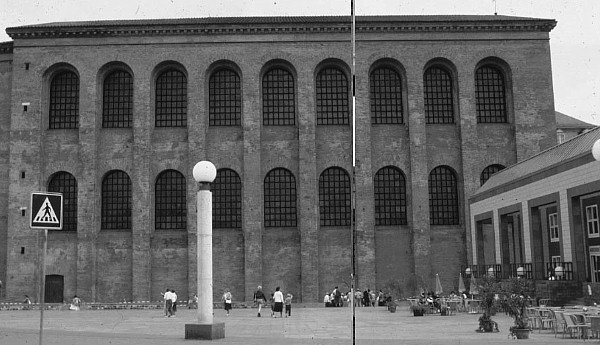
The brick building of the Aula Palatina - now named Basilica - dating from the period of Constatine the Great, approximately 310 A.D., and the Elector's Palace, partly Renaissance and partly Baroque in style, are now linked into one single and expansive architectural unit. This merger is a natural process in that it results from its uninterrupted use through the centuries, further indicated by the fact that all records invariably and without fail use its traditional name of "Palatium".
The Roman Palace's west wall and apse, dating from 310 A.D., built over a demolished palace of much smaller size whose foundations are recognizable underneath the later building, still stand at almost their original height (the wall's thickness is 2.30 - 3.40m). The interior of the gigantic hall (height 30m, width 27m and length 67m) - despite its dimensions perhaps only a sort of appendix to the Imperial residence proper - had been richly decorated with mosaics and marbles and the outside walls were well plastered and fitted along their whole length with a gallery underneath its windows (these were 7m high and 3.50m wide).
At the beginning of the 17th century, part of the building was pulled down (east -and south walls), and the remainder incorporated in the Renaissance Palace of the Prince Electors of Trier.
Following the Electorate's dissolution, e.g. during the neo-Romantic period (1846 - 56), it was rebuilt and since then, houses a Protestant church. Yet, the effect created by a building of such dimensions and, above all, the deep and lasting impression of its interior, remained unimpaired, and perhaps, the particular of the restoration work carried out after the sever damages of the last war, even deepened such impressions of magnificence and grandeur.
The Basilica stands in the middle of a former plateau, which in Roman times reached from St. Peter's Cathedral / Church of Our Lady up to the Imperial Thermae.

The basilica at Trier, the capital of Constantius in northern Gaul, is a plain rectangular hall, approximately 95 by 190 feet, with a sizable projecting semicircular apse, which held the emperor's throne. A narthex was in the front of the building and porticoed courtyards were on the sides. Two rows of windows bring in light from the sides and around the apse. The apse is emphasized by all aspects of the design. The exterior walls, once faced with stucco, are broken up by tall supporting Greek columns which end in arches. Originally a wooden gallery ran along the building under each row of windows, breaking up the vertical thrust of the arches.
| |

Basilika Palastaula
Augusta Treverorum, the audience or throne hall of Constantine, once part of a greater imperial palace, c. 310.
An even more striking example of the free flow of ideas and techniques is that afforded by the Audience Hall at Trier. At first glance one would take this for an up-to-date but otherwise ultra-typical example of contemporary metropolitan brick-faced concrete masonry. In reality it is built of solid brick, like the Kizil Avlu at Pergamon, and it is thus a seemingly unique example in the West of a method of construction which at this date we find only in Asia Minor. Whatever the eight of conservative architectural tradition in the average provincial city, here in the capitals of the Tetrarchy things were fast moving toward an architecture that was ecumenical in its range, transcending the barriers between one region and another and the even more formidable barrier that still separates East and West. (emphasis added)
J.B. Ward-Perkins, Roman Architecture (New York: Harry N. Abrams, 1977), p. 317.

On the Constantinsplatz stands the brick basilica, probably built during the reign of Constantine the Great. Converted into a palace for the Frankish kings and their deputies, it passed in 1197 to the archibishops. It was later restored (1846-56) and turned into a Protestant church. Adjoining the basilica are the electoral palace (1757-61) and the palace garden.
Wilhelm C. Bracht, "Trier" in Encyclopedia Britannica (Chicago: Encyclopedia Britannica, Inc., 1969) v.22, p. 230.
|